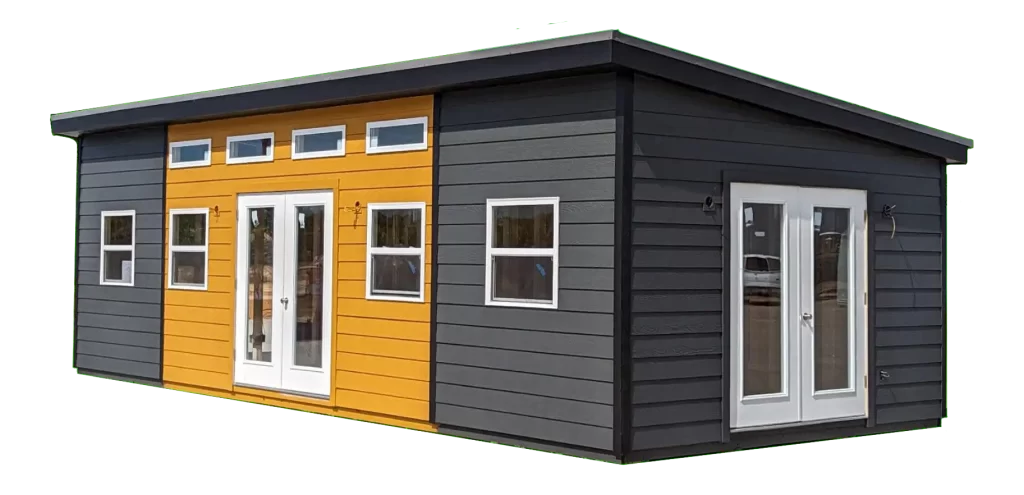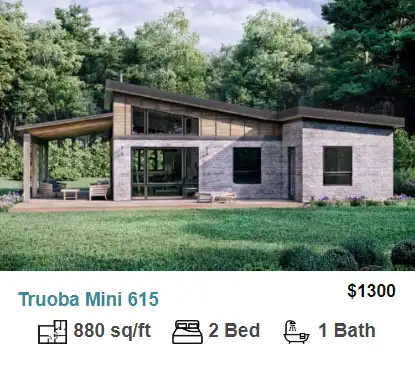Let’s look at the best options for tiny home heating and cooling. One of the biggest points to consider when planning your tiny home will be heating and cooling. Some important questions to ask:
- What is the best method for heating and cooling your tiny home?
- Does your interior allow for ductwork?
- How much wall space do you have to dedicate to a through-the-wall unit?
- What are the average winter and summer temperatures in your area?
Fortunately, the list of appropriate options is rather short. Most tiny home owners will find a PTAC, mini-split, or combination of window AC and space heaters suit their needs. Let’s meet the contenders.
Mini-Split – A mini-split is a unitary climate control system consisting of an outdoor base with one or more indoor heads. Mini-splits use a heat pump to fulfill heating needs.
PTAC – Packaged Thermal Air Conditioners are self-contained heating and air conditioning units that pass through the wall. They may use either a heat pump or electric heater and are designed for one open space.
Window AC – These small self-contained air conditioning units are designed to cool one room. As implied by the name they are often installed in a window, but can be permanently framed into walls.
Space Heater – The term space heater can refer to any small, self-contained heater designed to heat a small area. These can be oil-filled, radiator types or active resistance elements with fans among others.
Mini Split vs. PTAC
Mini splits easily take the win on cooling efficiency. The best PTAC units are available with an energy efficiency ratio (EER) of around 12 in cooling mode, whereas there are mini split units with an EER over 15. That results in an electricity savings of over 30% with the mini split. The other big advantage to mini-splits over PTAC units is the flexibility. Mini splits can be set up as multiple head systems for heating and cooling multiple closed off spaces while the PTAC is limited to heating and cooling a single open space. Not convinced? See what energystar.gov has to say about mini split efficiency.
The PTAC shines as being an all-in-one unit. The whole system is a box that mounts in the wall like a big window AC unit. Installation is much less complex and can easily be done by someone without any HVAC experience. Mini split systems often require charging by an HVAC professional.
What about the rest?
Window AC units and space heaters are the cheapest up front and easiest to install by far. But, this comes at the cost of long term efficiency. They are by far the least efficient option when compared to mini splits and PTACs. The sheer vastness of sizes and styles to choose from can however help to mitigate electrical cost by allowing you to choose models rated exactly for your size of building.
So, which should I choose?
Each option could be completely viable in almost any tiny home, but there are some clear instances when one is clearly superior to the others. Here are a few instances:
Weekend or seasonal use cabin. – Window AC and/or space heaters are perfect for the occasional getaway where efficiency isn’t as important, and maintenance/installation of a larger unit would be inconvenient.
Our pick for Window AC: Frigidaire FFRA062WAE Window-Mounted Room Air Conditioner
Our pick for Space Heater: De’Longhi DeLonghi TRD40615E Full Room Radiant Heater
500+ sq ft tiny home with several divided rooms. – This is where a mini split will shine. A multiple head unit will keep the individual rooms comfortable using far less electricity that a PTAC or multiple window units and space heaters.
Our pick for Mini-Split: Cooper & Hunter 24,000 BTU, 230V, 17 SEER Ductless Mini Split AC/Heating System Pre-Charged Inverter Heat Pump
500 sq ft or less tiny homes with an open design. – A PTAC is a great choice in this scenario. One simple unit to control the climate, just like a hotel room.
Our pick for PTAC: Amana 17,000 BTU Air Conditioner with 3.5 kW heat kit.
Off-Grid Solutions
So what if you are planning your getaway cabin miles from the nearest utilities? Let’s look at some options for off-grid comfort.
If we assume there is no electricity available from solar, a generator, etc., we’re left with some interesting heating options. Wood stoves and fireplaces are the classic solution and have a romantic appeal, but they come with some pretty heavy risks. Aside from the increased risk for a housefire, there are severe air quality threats associated with burning wood indoors. Check out this great article from the EPA before committing to wood heat. Beyond wood and electricity, we are left with packing in fuel. Of the choices, Propane is the most suitable and widely available option. 20lb bottles can be easily swapped out at most convenience stores with larger sizes being refillable at local propane dealers. Propane is extremely efficient at heating both your home and your water. Propane heating combined with a propane-fueled generator can be a great all-around off-grid energy solution. There are also cooling and refrigeration options available that are fueled directly by propane, no generator needed!
Don’t forget to insulate…
The path to efficiently heating and cooling your home starts with insulation. Not sure where to begin? Click here to check out our article on the best options for tiny home insulation.
Go forward with your knowledge and dare to live tiny!




